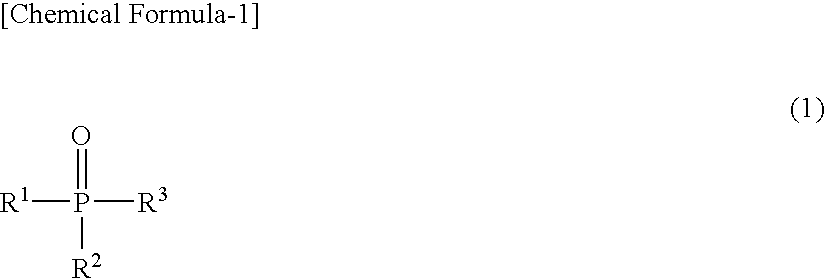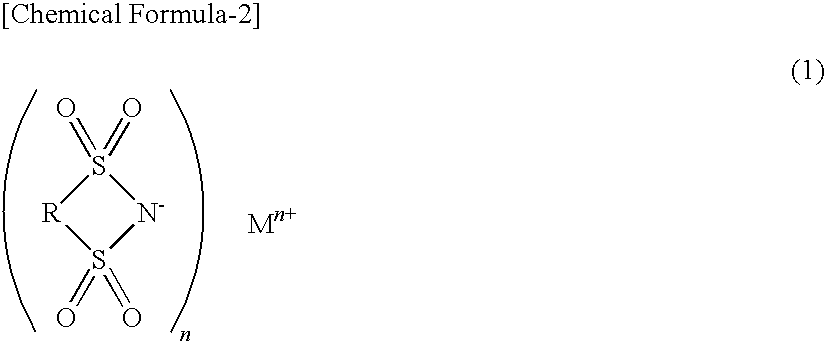Nonaqueous electrolyte for secondary battery and nonaqueous-electrolyte secondary battery employing the same
a secondary battery and nonaqueous electrolyte technology, applied in the direction of non-aqueous electrolyte cells, cell components, electrochemical generators, etc., can solve the problems of difficult use, and reducing discharge load characteristics, and achieve excellent discharge load characteristics, high-temperature storability and cycle characteristics, excellent discharge load characteristics
- Summary
- Abstract
- Description
- Claims
- Application Information
AI Technical Summary
Benefits of technology
Problems solved by technology
Method used
Image
Examples
embodiment 5-1
[0704]Nonaqueous electrolyte 5 of the invention is a nonaqueous electrolyte which includes a nonaqueous organic solvent and a lithium salt dissolved therein, and is characterized in that the nonaqueous organic solvent contains a cyclic polyamine compound and / or a cyclic polyamide compound and further contains at least one compound selected from the group consisting of unsaturated carbonates, fluorine-containing carbonates, monofluorophosphates, and difluorophosphates. This electrolyte is referred to as “embodiment 5-1”.
[1. Cyclic Polyamine Compound]
[0705][1-1. Kind]
[0706]The cyclic polyamine compound which may be contained in nonaqueous electrolyte 5 of the invention (hereinafter suitably referred to as “cyclic polyamine compound of invention 5”) is any of cyclic compounds having a structure formed by the condensation of one or more amines and derivatives of such cyclic compounds. Namely, the cyclic polyamine compound is any of cyclic compounds including two or more nitrogen atoms b...
embodiment 5-2
[0763]Another essential point of invention 5 resides in a nonaqueous electrolyte which includes a nonaqueous organic solvent and a lithium salt dissolved therein, and is characterized in that the nonaqueous organic solvent contains a cyclic polyamine compound and further contains at least one cyclic carbonate in an amount of from 5% by mass to 40% by mass based on the whole nonaqueous organic solvent. This electrolyte is referred to as “embodiment 5-2”.
[1. Cyclic Polyamine Compound]
[1-1. Kind]
[0764]The kind of the cyclic polyamine compound is as described above.
[0765][1-2. Composition]
[0766]The composition is as described above.
[2. Cyclic Carbonate]
[0767]The cyclic carbonate in invention 5 is not particularly limited so long as it is a cyclic carbonate. Part or all of the hydrogen atoms may have been replaced with a halogen, e.g., fluorine or chlorine. Examples thereof include ethylene carbonate, propylene carbonate, butylene carbonate, fluoroethylene carbonate, difluoroethylene car...
embodiment 5-3
[0778]Still another essential point of invention 5 resides in a nonaqueous electrolyte which includes a nonaqueous organic solvent and a lithium salt dissolved therein, and is characterized by containing a cyclic polyamide compound. This electrolyte is referred to as “embodiment 5-3”.
[1. Cyclic Polyamide Compound]
[0779][1-1. Kind]
[0780]The kind of the cyclic polyamide compound is as described above.
[0781][1-2. Composition]
[0782]The composition is as described above.
[2. Nonaqueous Organic Solvent]
[0783]Usable nonaqueous solvents are as described above.
[0784]The reason why a cyclic polyamide compound, even when used alone, enables the effects of this invention to be produced is as follows. In a cyclic polyamide compound, the unshared electron pairs on the respective nitrogen atoms are in a delocalized state due to the influence of the adjoining carbonyl groups. Cyclic polyamide compounds hence have far lower basicity than cyclic polyamine compounds. Because of this, even when a solven...
PUM
| Property | Measurement | Unit |
|---|---|---|
| coefficient of viscosity | aaaaa | aaaaa |
| coefficient of viscosity | aaaaa | aaaaa |
| voltage | aaaaa | aaaaa |
Abstract
Description
Claims
Application Information
 Login to View More
Login to View More - R&D
- Intellectual Property
- Life Sciences
- Materials
- Tech Scout
- Unparalleled Data Quality
- Higher Quality Content
- 60% Fewer Hallucinations
Browse by: Latest US Patents, China's latest patents, Technical Efficacy Thesaurus, Application Domain, Technology Topic, Popular Technical Reports.
© 2025 PatSnap. All rights reserved.Legal|Privacy policy|Modern Slavery Act Transparency Statement|Sitemap|About US| Contact US: help@patsnap.com



